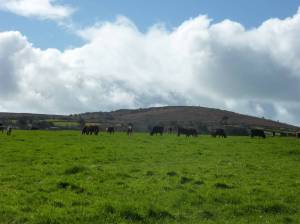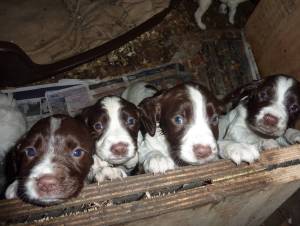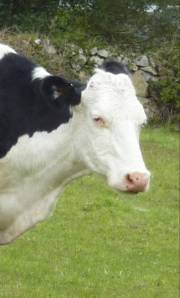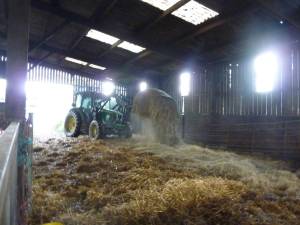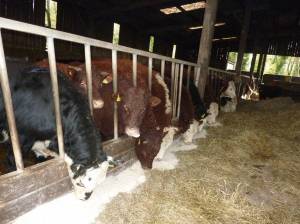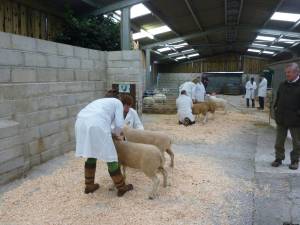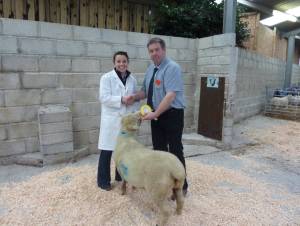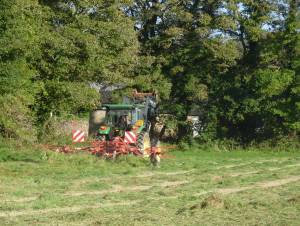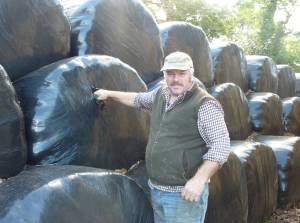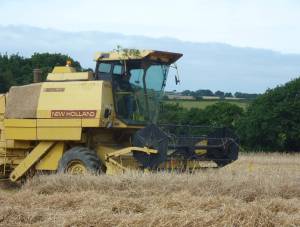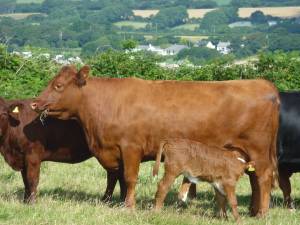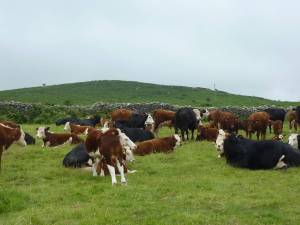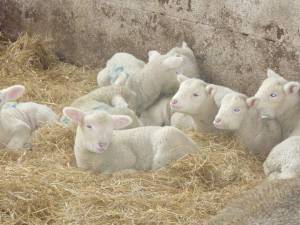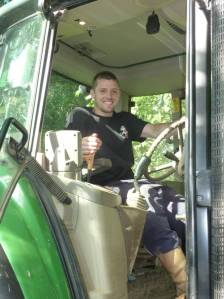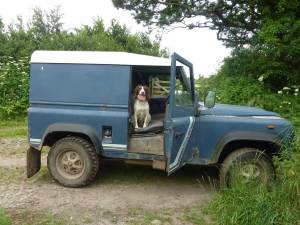January has been a very busy month on Mark’s Farm, 2014 began with a flying start with new calves, new lambs and a new baby all on the first of the month.

The New Year’s Day calf
Mark and his family have had several little surprises over January. This little man arrived on 1 January and, with the exception of one little calf, Flash who we will introduce to you later, all are doing well having made a smooth transition to the world with just the help of their mum.

Gracie and her new lamb
Gracie the show sheep, also gave birth on New Year’s Day. She had a good sized, healthy ewe lamb. This ewe lamb will be staying in the flock, and although it is still early days, Mark hopes to take her to a show or two in the upcoming year. Mark’s grandson Brook has named her Sky.
The ewes have been steadily lambing ever since, with Ruth and Jessie taking turns on the 11pm, 3am and 6am night shifts as well as every few hours during the day. It is really important that should the ewe have any difficulties they assist her to get the lamb out as smoothly as possible.
Ideally, they would like all the first time mums to have singles so they get a feel for motherhood, from the second year onwards twins are preferred. Triplets on one ewe are avoided where possible, as it often has negative health implications on the ewe and each of her three lambs.
A third arrival on New Year’s Day was Daniel and Vickie’s third son, Joey. Brother to Brook and Zak who already love tractors, cows and mud, they are sure Joey will be no exception and welcome him in to the Pascoe family.


Daniel and Mark have also been busy researching replacements for their dungspreader and tractor.

The tractor and dungspreader
This new tractor will have better fuel economy than its predecessor, and should reduce its carbon foot print. The Fendt tractors also have a good reputation for reliability and the family will have to wait and see if this has been a worthwhile purchase, as Daniel puts the tractor through its paces.
Mark has also purchased a rear discharge dungspreader, which is designed to chop the straw dung up and spread it evenly over the land. The large wheels reduce soil compaction and allow Mark and Daniel to get the organic straw dung out of the shed and on to the fields as soon as possible, so it can start putting nutrients back into the ground completing the cycle for another year.
Defra regularly ask Mark to test the herds on the Godolphin estate for TB. Currently Godolphin has a ‘TB free’ status and is not due another test until April this year, although Defra can ask Mark to test whenever they feel it is necessary.
Cattle rarely show symptoms of TB until it reaches advanced stages. To test for the disease a Defra appointed vet will inject all the cattle. They are then examined three days later by the same vet, who measures their reaction to the original injection making note of any he believes are infected. The vet is looking for a thickening of the skin in the area where he made the original injection. Any infected animals are destroyed and although Defra pay compensation, it is still heartbreaking to see any animal loaded on to the lorry for slaughter. This is an agonising time for any farmer, but a reality they are getting used to.
This month Defra contacted Mark asking him to complete a tracer test at Godolphin. Mark’s own farm has been diagnosed with TB, so he is no longer allowed to move any animals off the farm until he receives a clear status. The three animals he had moved to Godolphin during 2013 were listed as requiring tracer tests.

The weather wasn’t great on the day of the tracer tests
Supercharge the bull, a cow and a young Ruby Red were tested and all had clear results. The weather was appalling on test day, and Mark was glad it was just the three that needed testing, definitely a day for wet weather overalls!
Flash has had a difficult start to life. Nicknamed because of the flash of brown across her face she is quite the character. Flash is only a week old and doesn’t appear to be getting the important milk she needs from her mother, she has been lethargic and her stomach looks sucked in.Flash’s mother is one of Mark’s older cows, and she has always been a good mother in the past. Year after year of milk production has taken its toll and her udder now hangs low to the floor, her teats also seem too big for Flash to grip.

Flash and her mother
Mark had to act quickly once the problem was diagnosed, but he was reluctant to separate the cow and calf unless absolutely necessary. It is vital that Flash gets milk from her mother in the first few stages as it is rich with antibodies. Despite Flash’s and her mother’s best efforts the calf’s health was deteriorating quickly.
The next step has been to load the cow into the cattle crush, and use the calf’s suck reflex firstly on the fingers, before moving the calf into position to suck from the cow’s teat. This way Mark knows the calf has had milk that day. It is important to hold the teat in position until the calf has had enough.

 This is hard work for Mark, and the weather has been horrendous. Matters are made worse by the cow having lost the use of one of her back teats, during a previous mastitis infection. This milking process needs to be repeated twice a day until the calf can begin to drink on its own. Unfortunately, this calf may not make it, the cow is likely to be ear marked for sale. Fingers crossed Flash will get better each day.
This is hard work for Mark, and the weather has been horrendous. Matters are made worse by the cow having lost the use of one of her back teats, during a previous mastitis infection. This milking process needs to be repeated twice a day until the calf can begin to drink on its own. Unfortunately, this calf may not make it, the cow is likely to be ear marked for sale. Fingers crossed Flash will get better each day.
The lambs are growing and getting personalities of their own, here is Sky after 20 days.

Sky with her mum
Once born the lambs and their mums are put in a 6ft x 6ft pen to bond. Their navals are dipped in an orange, iodine solution to reduce the risk of infection from any bacteria they may come in to contact with.


After a few days they are then put into a nursery pen, a pen of 5-6 ewes and lambs, where the lambs really start to find their feet before joining the older lambs out in the field.

Ruth with a new lamb
The lambs are sprayed with the ewe’s identification number on their side, making them easily identifiable during the first month. This allows Ruth to keep an eye on any ewes and lambs which are underperforming and made need separating for some extra attention.The lambs also have a rubber ring placed on their tail, causing the lower section to die and drop off over time. This makes it harder for any foxes to catch the lambs and makes it less likely to snag on fences etc.The male lambs also have a ring placed on their testicles to stop any unwanted pregnancies when they grow older. The lambs quickly lose feeling in these areas and after a few minutes they forget it’s even there.
All the new lambs are given an ear tag, blue for boys and pink for girls, showing their individual number. This is for management purposes and allows Mark to identify each lamb personally. The best girls will be kept in the flock and will be double tagged with an electronic ear tag at a later stage. The other lambs will eventually be sent for slaughter.
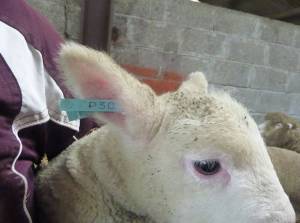
Below, this little ram lamb is just hours old and well worth getting up for at 3am to ensure he made it into the world safely.
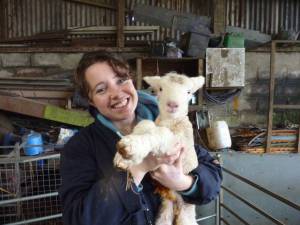
Jess with a newborn ram lamb
Next month find out how Flash is getting on, as well as…
- More baby calves
- More baby lambs
- Trimming and management on the upper fields
- Dung spreading










